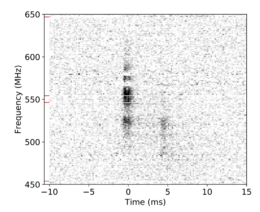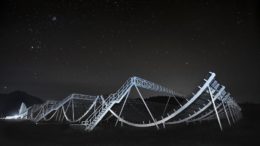Fast radio bursts (FRBs) are brief radio signals that last on the order of milliseconds. They appear to be extragalactic, coming from small, point-like areas on the sky. Some FRBs are one-off events, while others are periodic or “repeating”. The sources of FRBs are still unknown, but binary neutron star systems might be a piece of the puzzle.
Wanted: A Reliable Source of Repeating Fast Radio Bursts
- Repeating bursts from a given FRB source are consistent in frequency and overall intensity on the timescale of years.
- Bursts exhibit small-scale variations in measures of the source’s magnetic environment.
- FRBs seem to be preferentially hosted in massive, Milky-Way-like galaxies.

Example of an FRB from a repeating source, showing the intensity and various frequencies contained in a single burst (darker means more intense, lighter means less intense). The red lines just below and above 550 MHz and those near 450 MHz and 650 MHz indicate frequencies that were unused due to other radio signals interfering [adapted from the CHIME/FRB Collaboration, Andersen et al. 2019].
In a recent study, Bing Zhang (University of Nevada Las Vegas; Kyoto University, Japan) attempts to explain repeating FRBs using BNSs in a novel way. Instead of considering the neutron-star merger itself, Zhang examined whether the years leading up to the merger could produce repeating FRBs.
A Magnetic Dance
Repeating FRBs put out an enormous amount of energy over a few milliseconds — at least as much energy as the Sun puts out over three days. To put constraints on the average FRB-producing BNS, Zhang used the double-pulsar system PSR J0737-3039A/B (pulsars are fast-rotating neutron stars with strong magnetic fields), which is very well characterized in terms of its component stars and overall structure.
Aside from having enormous amounts of rotational energy intrinsically and in their orbits, BNSs also have strong magnetic fields. These magnetic fields are key to the production of FRBs in Zhang’s scenario — as the neutron stars orbit each other, their magnetic fields interact, possibly triggering a flow of particles that would produce FRBs.
On the scale of centuries or even decades pre-merger, these triggers could occur repeatedly and consistently, satisfying a key requirement for repeating FRBs. This picture of interacting magnetic fields would also explain the small-scale variations in the magnetic environment measures, and there is an overlap between the sorts of galaxies that host FRBs and those that host the gamma-ray bursts that could be associated with BNS mergers.

Photograph of the CHIME radio telescope in British Columbia. [Andre Renard/Dunlap Institute/CHIME Collaboration]
By Way of Gravitational Waves
An observational test for this scenario is the detection of gravitational waves from an FRB source. Space-based gravitational wave detectors, such as the Laser Interferometer Space Antenna, would be well-suited for this. Ground-based detectors would also play a role, picking up waves from the BNSs actually merging.
And of course, the more FRBs we observe, the more we can narrow down their properties and sources. Fortunately, the Canadian Hydrogen Intensity Mapping Experiment (CHIME) is predicted to detect 2 to 50 FRBs per day, and other radio telescopes are hard at work as well. So maybe this FRB mystery will be solved sooner than we think!
Citation
“Fast Radio Bursts from Interacting Binary Neutron Star Systems,” Bing Zhang 2020 ApJL 890 L24. https://doi.org/10.3847/2041-8213/ab7244


2 Comments
Pingback: From AAS NOVA: ” Signals from Neutron Star Binaries” | sciencesprings
Pingback: Fast Radio Bursts - finally solved! - Paradigm Revolution